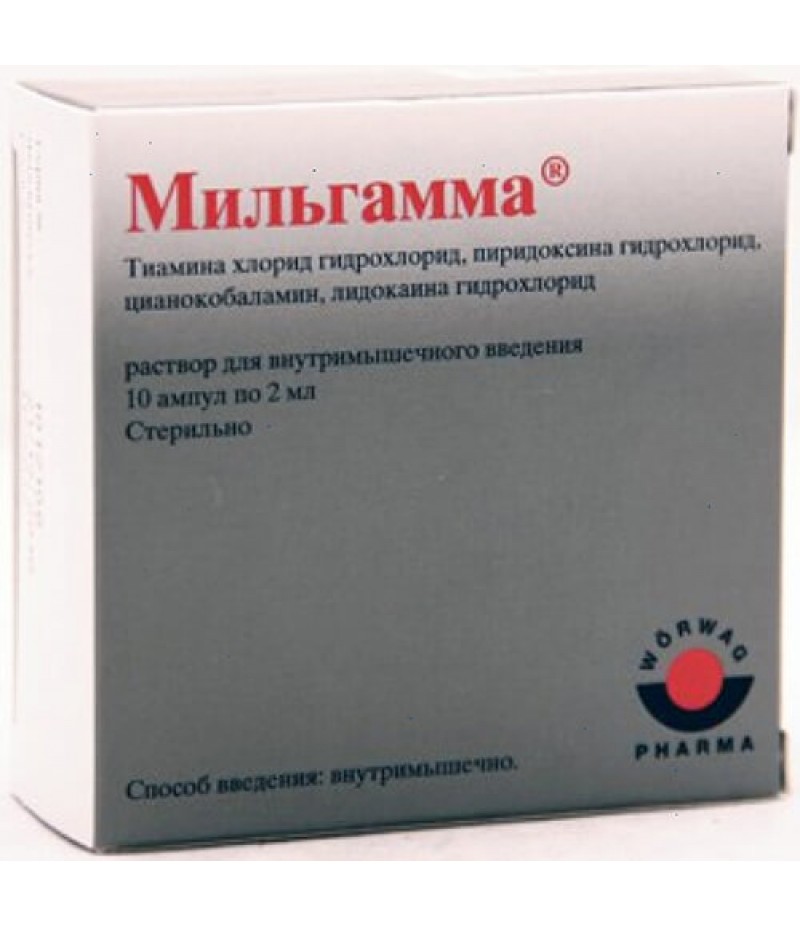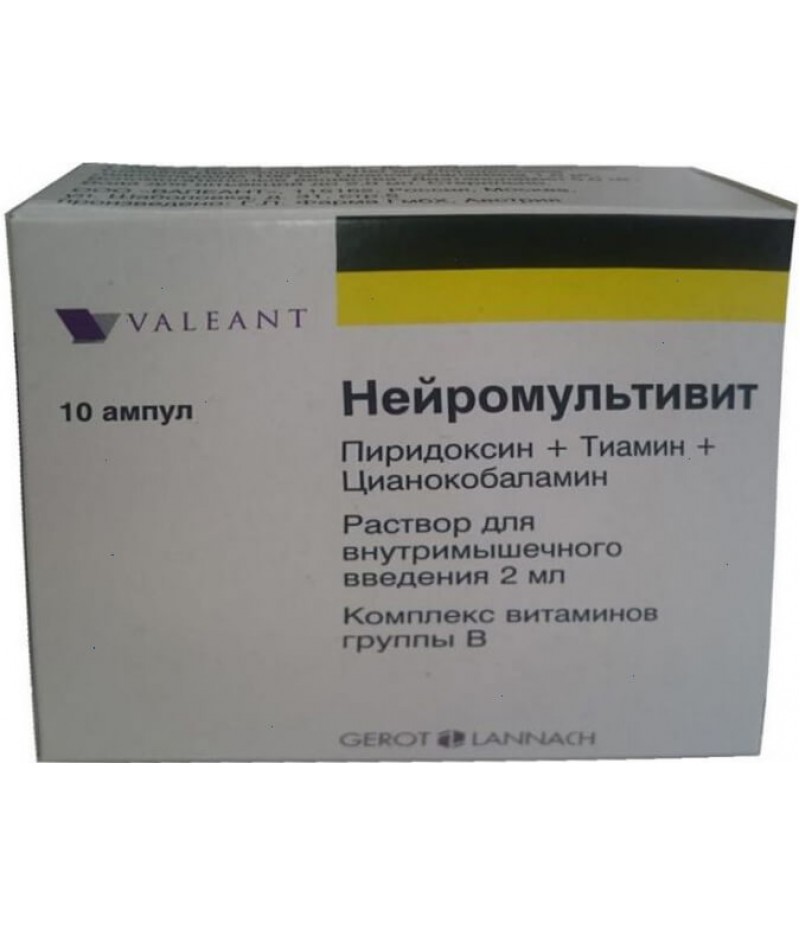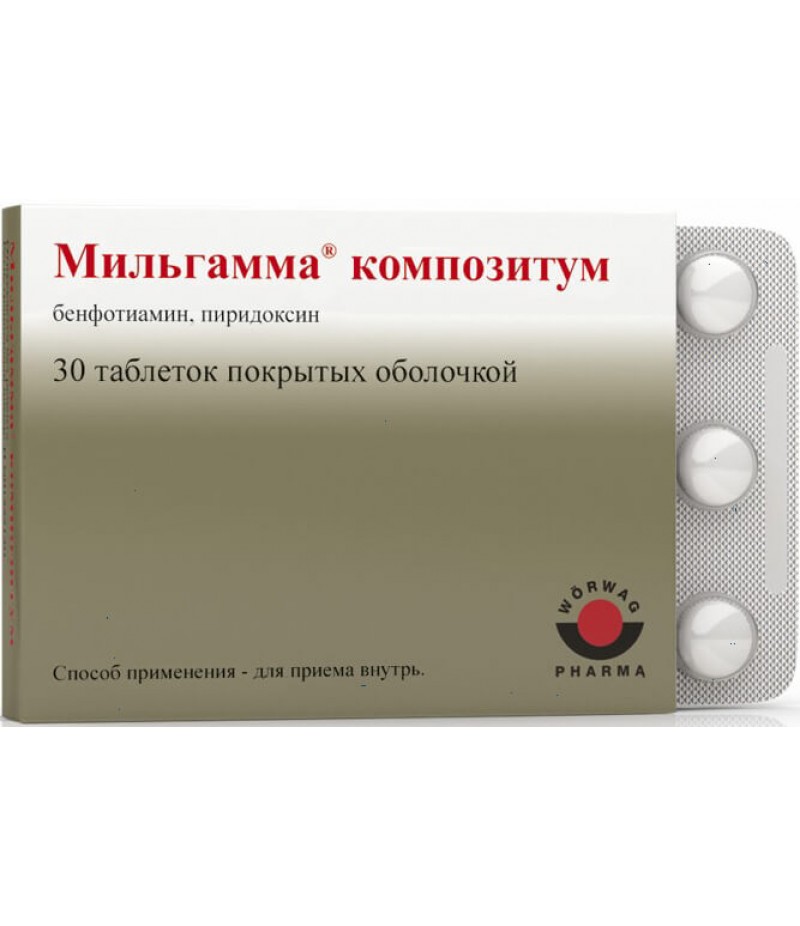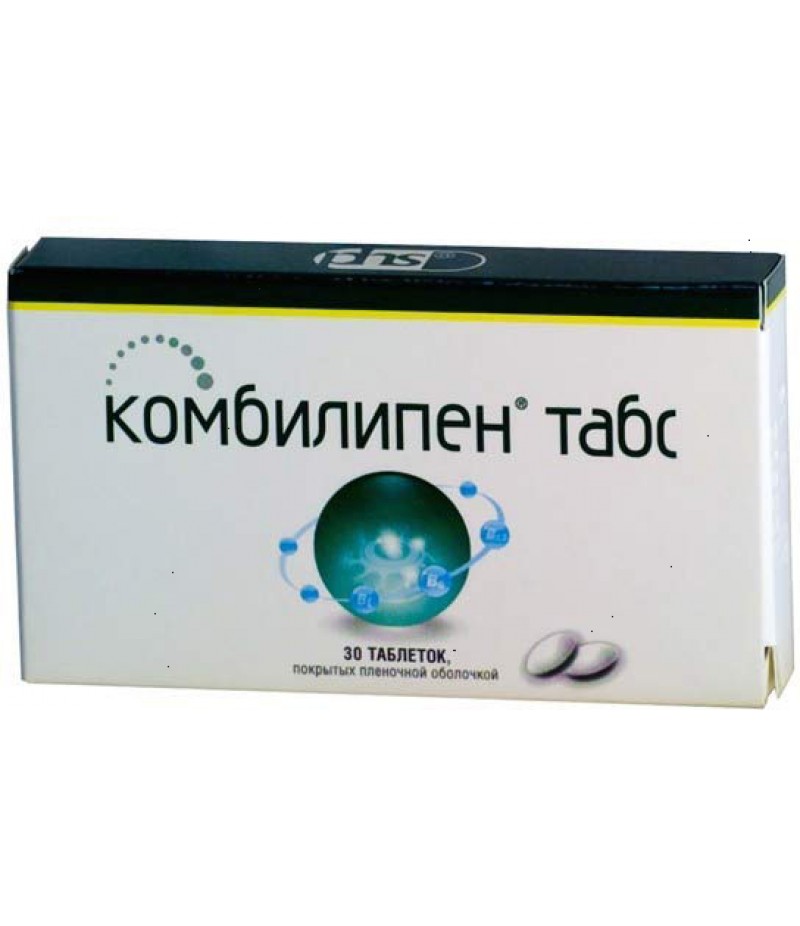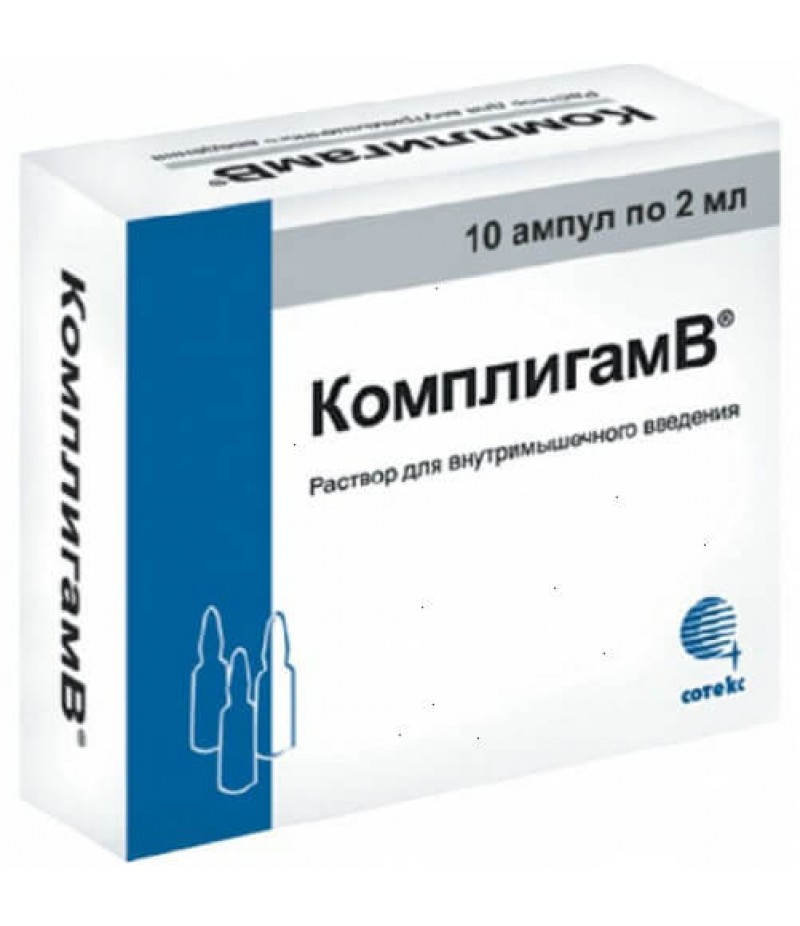Milgamma solution 2ml #10
- $29.56
- 3 or more $28.40
- Availability:In Stock
User manual for MilgammaYou can buy Milgamma on this pageCompositionThe composition of Milgamma in the form of a solution for intramuscular injection includes several active substances. In particular, the composition of ampoules i..
Tags: solution
User manual for Milgamma
You can buy Milgamma on this page
Composition
The composition of Milgamma in the form of a solution for intramuscular injection includes several active substances. In particular, the composition of ampoules includes: pyridoxine hydrochloride, thiamine hydrochloride, cyanocobalamin, lidocaine hydrochloride.
Also in the composition of injections Milgamma contain additional substances: benzyl alcohol, potassium hexacyanoferrate, sodium hydroxide, sodium polyphosphate, water for injection.
Vitamins in tablets contain benfotiamine, pyridoxine hydrochloride, and also they contain silicon anhydrous colloid, sodium croscarmellose, microcrystalline cellulose, talc, povidone K30, partial long chain glycerides.
Form of issue
The medicine is available as a solution (injections of Milgamma for intramuscular injection), as well as in the form of tablets and dragees.
Vitamins in the form of a solution are contained in ampoules of 2 ml. Ampoules are made of brown hydrolytic glass, on each of them there is a label and a white dot. In the package - 5 or 10 ampoules.
The tablets covered with a cover, are packed on 30 or on 60 pieces.
Also Milgamma Compositum is produced - biconvex, round, white. Dragee is contained in a contour squamous package of 15 pieces. In a cardboard bundle there may be 2 or 4 blisters.
pharmachologic effect
Milgamma contains neurotropic vitamins that belong to group B. The drug is used in a therapeutic dose for diseases of nerves, nervous tissue, in which patients have a disorder of nerve conduction or inflammatory-degenerative phenomena.
The drug Milgamma is also prescribed for people with diseases of the musculoskeletal system. The use of a drug containing large doses of vitamin B, relieves acute pain, activates microcirculation, improves blood formation and the functioning of the nervous system.
Vitamin B1 (thiamine), getting into the body, through phosphorylation is converted into cocarboxylase and thiamine triphosphate. In turn, cocarboxylase takes part in the processes of carbohydrate metabolism, normalizing the functions of the nervous tissue and nerves and improving conduction in the nerves. If the body is deficient in vitamin B1, then tissues can accumulate under-oxidized products of carbohydrate metabolism, provoking a variety of pathological conditions.
Determining what is better - injections or tablets Milgamma, it should be noted that in tablets instead of thiamine chloride in the composition is benfotiamin, fat-soluble thiamine derivative.
Vitamin B6 (pyridoxine), getting into the body, is phosphorylated. The products of its metabolism are involved in the decarboxylation of amino acids, which results in the production of physiologically active mediators - adrenaline, histamine, tyramine, dopamine, serotonin. In addition, vitamin B6 has an effect on the metabolism of tryptophan.
Vitamins B1 and B6 provide potentiation of influence of each other, therefore Milgamma vitamins in injections and tablets have a pronounced beneficial effect on the health of patients with diseases of the nerves and motor apparatus.
Vitamin B12 (cyanocobalamin) has an anti-anemic effect, activates the synthesis of nucleic acids, choline, creatinine, methionine. Takes part in metabolic processes in cells. The substance reduces the pain manifested by the defeat of the peripheral HC, activates the nucleic acid metabolism.
Lidocaine has a local anesthetic effect.
Pharmacokinetics and pharmacodynamics
Abstract indicates that after intramuscular injection thiamine is rapidly absorbed and enters the blood. In the body it is distributed unevenly. Since there are no significant amounts of thiamine in the body, it must be supplied every day. The substance can penetrate through the blood-brain and placental barriers. It is excreted through the kidneys. Thiamine, in comparison with other vitamins, is preserved in the body in the least amount.
Pyridoxine, after the solution was injected intramuscularly, quickly enters the bloodstream and is distributed throughout the body. About 80% of the vitamin binds to plasma proteins. The substance is able to penetrate the placenta, enters the mother's milk. Later it is oxidized to 4-pyridoxic acid, which is excreted after 2-5 hours through the kidneys.
Cyanocobalamin, getting into human blood, binds to proteins, resulting in the formation of a transport complex. Further in this form it is absorbed by the hepatic tissue. It also accumulates in the bone marrow. After cyanocobalamin is released from the bile into the intestine, it can again be absorbed.
Indications for use Milgamma
The solution and tablets are appointed as part of the complex treatment of diseases and syndromes of the nervous system of different origins.
The following indications for the use of Milgamma are determined:
neuritis;
neuralgia;
retrobulbar neuritis;
paresis of the facial nerve;
ganglionitis (including herpes zoster);
Neuropathy;
plexopathy;
alcoholic, diabetic polyneuropathy.
Also, indications for the use of injections are in people suffering from nocturnal cramps, neurological symptoms of spinal osteochondrosis. What helps the drug as part of complex therapy, and from which the injections of Milgamma are prescribed, you can find out more in detail with your doctor.
Contraindications to Milgamma
Contraindications to the use of the drug are as follows:
high level of sensitivity to its components;
decompensated heart failure.
Also, contraindications to injections and pills are pregnancy, lactation time and the child's age of the patient.
Side effects
Side effects of Milgamma are manifested, as a rule, in rare cases.
In particular, the following side effects are rarely possible:
Immune system: allergic manifestations.
Nervous system: impaired consciousness, dizziness.
Cardiovascular system: tachycardia, arrhythmia, bradycardia.
Digestive system: vomiting.
Skin: severe sweating, itching, acne.
Musculoskeletal and connective tissue: convulsions.
Sometimes, after the patient is injected with Milgamma IV, irritation may occur in the place where the solution was injected. The manifestation of systemic reactions can be noted only with very rapid administration or in case of an overdose.
If any other side effects occur or the above-described adverse effects are exacerbated, you should immediately tell the expert who will give advice on how to stab the ampoules, or replace the drug.
Instructions for use Milgamma (Method and dosage)
If a patient is prescribed Milgamma injections, the instructions for use should be carefully observed. Initially, the drug is injected deep into the muscle 2 ml once a day for 5-10 days. If injections are intended for maintenance treatment, then 2 ml is administered 2-3 times a week. It is also possible for maintenance therapy to take the drug in the form of tablets (1 tablet daily).
Instructions for use Milgamma indicates that to quickly eliminate pain, you should use ampoules or tablets (1 tablet three times a day). Treatment can last about one month. The patient's state of health should be monitored by the doctor weekly. Experts advise as soon as possible to switch to the internal reception of the drug. It should be noted that Milgamma candles are not produced.
The course of treatment with injections can last longer only on the instructions of a doctor. How often it is possible to prick injections, and which form of release is preferable in each particular case, should also be asked by the attending physician.
Overdose
If an overdose of the drug is noted, the patient may exhibit those symptoms that are described as side effects. In such cases, symptomatic therapy is used.
Interaction
If vitamin B1 is mixed with sulfate solutions, it completely decays.
Inactivation of thiamine (benfotiamine) is noted in the presence of acetates, mercury chloride, iodides, carbonates, riboflavin, tannic acid, iron ammonium citrate, penicillin, metabisulphite.
Pyridoxine in therapeutic doses can reduce the effect of levodopa, so it is not used with levodopa and the drugs containing it. There is also an interaction with penicillamine, cycloserine, isoniazid.
Cyanocobalamin is inactivated in the presence of salts of heavy metals. Riboflavin also has a destructive effect, especially with parallel exposure to light.
Storage conditions
The product should be protected from light, stored at a temperature not exceeding 15 ° C. Do not allow children to access.
Shelf life - 2 years.
special instructions
If the solution was accidentally injected intravenously, the patient should be sure to ensure the observation of the doctor and symptomatic treatment of adverse events.
There is no data on the impact on the ability to drive vehicles and work with precise mechanisms.
Wikipedia testifies that in veterinary practice the remedy can be used for dogs and other animals. However, it should be noted that such use of injections is possible only after a clear appointment of a veterinarian.
Neuromultivit or Milgamma: Which is better?
The composition of these drugs is similar, but neuromultivitis does not have lidocaine as a component. Neuromultivitis, unlike Milgamma, is prescribed for the treatment of children. For what each of the drugs is prescribed, the treating specialist will explain in more detail.
Children
The drug is prescribed to adolescents only from the age of 16.
With alcohol
Milgamma is prescribed after alcohol intoxication in order to restore the body. At the same time, alcohol and Milgamma, both in injections and in tablets, should not be consumed. Despite the fact that compatibility with alcohol of this drug in the official instruction is not described, this combination completely neutralizes the positive effect of the drug. Also a number of side effects can provoke the combination of alcohol and lidocaine: it is a headache, drowsiness, a state of anxiety.
In pregnancy and lactation
At pregnancy, and also during feeding Milgamma to women it is not appointed, as there is no sufficient information on influence of its components on a fetus at pregnancy and during breast-feeding.
Reviews about Milgamma
There are numerous reviews about Milgamma, which are left as patients who underwent such treatment, and specialists. In the reviews it is noted that injections are intramuscularly painful, sometimes there is irritation at the place where the injection was administered. But more often the positive effect is described in the treatment of neuralgia, neuritis and other diseases, which were noted after the patient was injected with Milgamma injections. The doctors' comments contain information that during the treatment patients should lead a correct lifestyle and follow all the recommendations, as the remedy removes only the symptoms, but not the cause of the ailments.
Often, the effectiveness of the drug in complex therapy is also noted, for which it is prescribed not only this drug, but also other medications. For example, a good effect can be obtained if Movalis and Milgamma are assigned simultaneously. Movalis is a non-steroidal anti-inflammatory drug that exerts a pronounced positive effect in diseases of the musculoskeletal system.

